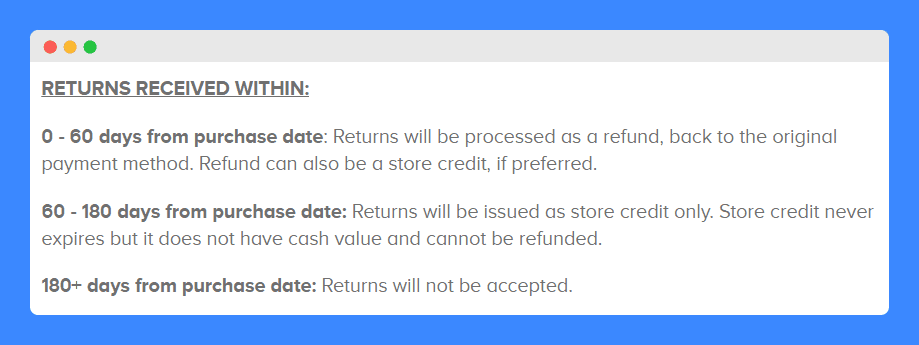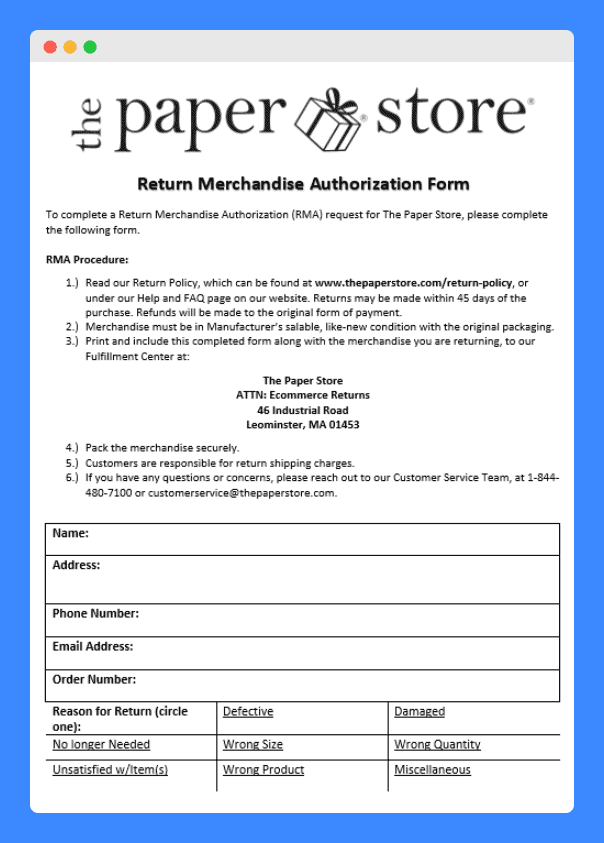If you own an online store, you know just how important it is to have a well-drafted return policy. A return policy is a set of guidelines that informs customers about their rights and responsibilities when they wish to return purchased goods.
With this policy in place, you not only protect your business but also boost customer confidence, encouraging more purchases.
The challenge is learning how to write a return policy that’s clear, concise, and fair for everyone. Below, I’ll walk you through what a well-written return policy should cover, offer valuable tips, and even discuss the pros and cons of crafting your own policy.
- A well-written return policy helps protect your business and encourage more purchases. However, it has to be concise, clear, easy to find, and fair for both parties.
- Save time and money by using a return policy generator. These tools offer templates, customization options, and legal expertise to create a policy that’s perfect for your store.
- Use your return policy as a selling point! Offer features like free return shipping or extended return windows to position your store as customer-centric.
Table of Contents
PRO TIP: Take the hassle of writing your own return policy away with our return and refund policy generator trusted by over 200,000 businesses. It’ll save you hours of work and help increase sales in minutes.
1. State the Time Frame for Returns
Setting a clear return window is important in managing customer expectations and operational efficiency. A common practice is to establish a 30-day return policy.
Customers need to know how long they have to return a product after purchase. This time frame strikes a balance between giving them enough time to decide if they are satisfied with their purchase and allowing you to manage returns efficiently.
PRO TIP: Make sure to communicate this period prominently within your return guidelines to ensure it is seen and understood by all potential buyers.
2. Specify the Condition of Items Eligible for Return
Outline the return conditions that must be met before a return is accepted. This includes detailing the state in which items need to be returned, such as unused, unwashed, and in their original packaging with all tags attached.
Here’s a sample return policy from New Balance that states eligible items must be in new condition:

By setting these criteria, New Balance protects its inventory from damage and misuse, ensuring returned items are in a condition that allows for resale.
3. Detail the Refund Process and Options
Customers want to know what happens to their money after they return an item. A clear explanation of your return and refund policies will help avoid any confusion here.
When detailing the refund process, specify whether customers can return products for a full refund, store credit, or exchange. Also, define the conditions under which each option is available and the steps the customer must follow to initiate a refund.
Here is how Paula’s Choice makes sure it remains fair to its customers and the business:

4. Explain Exchange Procedures
This part of a returns and exchanges policy lets customers know they can return the product for an exchange or store credit if it doesn’t meet their needs.
Do they need to return the original product first? Can they exchange for a different size or color, or only for the same item? Knowing they have this option will encourage more customers to make a purchase.
Not all customers want their money back. Some might prefer to exchange an item for a different size, color, or style. So, outline the steps involved in exchanging an item.
5. Outline the Steps for Initiating a Return
Your eCommerce store should have clear return procedures outlined in your policy. To do this, start by explaining how customers can request a return, which may include filling out a form on your website or contacting customer service.
For better organization and tracking, you can use a Return Merchandise Authorization system, like this one from The Paper Store:

An RMA system requires customers to obtain an authorization number before sending a product back. This step helps manage returns efficiently and allows you to inspect returned items systematically.
6. Mention Any Restocking Fees or Charges
Imagine a customer goes through the trouble of packaging and shipping a return, only to find out there’s an unexpected restocking fee. Understandably, this can be frustrating.
As Steve Cannon, CEO of Mercedes Benz USA, emphasizes,
“Customer experience better be at the top of your list when it comes to priorities in your organization. Customer experience is the new marketing.”
If you want to give your customers the best experience, be upfront about any charges associated with trying to return an item. Typically, this covers the cost of processing the return and restocking, which can vary depending on the product type or the reason for the return.
7. Clarify Responsibility for Return Shipping Costs
Considering free shipping on returns could significantly enhance customer satisfaction and sales. In fact, a 2022 survey indicated that nearly two-thirds (63 percent) of U.S. shoppers are much more likely to shop at an online store if it were to offer free returns.
If you don’t, consider highlighting any exceptions, such as free return shipping for damaged or defective items. By being transparent, you can avoid cart abandonment and encourage customers to complete their purchases.
Clearly state in your policy whether you or the customer will bear the return costs. Transparency in this area can greatly influence a customer’s decision to purchase.
8. Provide Instructions for Packaging and Sending Returns
A great return policy should clearly outline the instructions for packaging and sending returns. Do you provide pre-paid return labels to simplify the process? If so, explain how customers can obtain them.
Moreover, specify any packaging requirements, such as using the original box or including packing materials.
Look at the example below from Kirrin Finch:

By providing clear, simple steps in its return policy, Kirrin Finch is able to encourage compliance and reduce the chances of errors during the return process.
9. Include Information on Processing Time for Returns
A clear return or exchange policy helps set proper expectations. You want to be transparent about the timeline from when a return is sent back to when the customer can expect a refund or exchange to be completed.
Generally, it’s advisable to process returns within a specified timeframe, such as 7-14 business days. This ensures customers are not left waiting and are more likely to have a positive experience with your online store.
10. Offer Contact Information for Customer Support Regarding Returns
Including detailed return information in your policy is crucial for supporting customers who want to make a return.
Always provide clear contact information for your customer support team, such as an email address, phone number, or a direct link to a contact form on your website. Here’s a clear return policy example from Bruvi:

By linking their Contact Us page, customers can easily reach out with questions or issues related to their returns. In turn, Bruvi showed commitment to customer service and enhanced the overall return experience.
PRO TIP: Consider offering multiple ways for customers to contact your store, such as email, phone, or live chat. This ensures they have convenient options to get assistance.
Tips for Writing a Bulletproof Return Policy
Whether you own a large or small business, you need a bulletproof return policy to ensure customer satisfaction and maintain a reputable online presence. While the steps outlined above provide a solid foundation, here are some additional tips to consider:
Use Plain Language
Good eCommerce return policies are written in simple, straightforward language. Avoid legal jargon that might confuse customers. A clear, understandable policy ensures better compliance and fewer misunderstandings.
Be Specific About Exclusions
Detail any specific items or categories that are excluded from returns. For example, perishable goods, personalized items, or sale items might not be eligible for returns.
Highlight Key Points
Use bullet points or bold text to highlight key aspects of your return policy, such as time frames, conditions for returns, and refund options. This makes the information easier to find and understand at a glance.
Align with Industry Standards
Ensure your policy aligns with industry standards and best practices. Compare it with those of similar businesses to ensure you’re competitive and fair. If you’re going to use a clear return and refund policy template, customize it to your business needs.
Provide Examples
Include examples to illustrate the policy in action, such as step-by-step instructions for a typical return. Examples help demystify the process for customers and guide them through your specific procedures.
Include a FAQ Section
Add a frequently asked questions (FAQ) section related to returns. This section can cover common concerns and scenarios, providing clarity and saving time for both you and your customers.
Update Policies Regularly
Review and update your return policy regularly to adapt to changes in your business model, customer feedback, or legal requirements. This ensures your policy remains relevant and effective.
Dos and Don’ts When Writing a Return Policy for Your Website
More than legal compliance, a return policy is a strategic element of customer service and marketing. To make your return policy work for you and your customers, consider these essential dos and don’ts:
Dos
- Always display your return policy in a prominent location on your website. It’s a good idea to feature your return policy in the footer, on product pages, and during checkout.
- Incorporate security measures. Address privacy concerns by outlining how you handle personal data collected during the return process in accordance with your privacy policy.
- Feature your return policy as a selling point. This can incentivize purchases and position your business as customer-centric.
- Educate your staff. Make sure that all employees have a copy of your return policy so they can provide accurate information and assistance to customers.
Don’ts
- Avoid rigid policies. Do not create overly strict return policies that may deter customers from making purchases. Flexibility can lead to increased customer loyalty.
- Do not ignore customer feedback. Do not dismiss complaints or suggestions regarding your return policy. Feedback can be crucial for improving processes and customer satisfaction.
- Never falsify information. Do not misrepresent aspects of your policy or the condition of returned goods to avoid refunds. This could lead to disputes and damage your reputation.
- Do not ignore return fraud. Be aware of common types of return fraud and implement procedures to detect and prevent them, such as requiring identification or tracking return patterns.
The Pros and Cons of Writing Your Own Return Policy
Writing your own return policy can seem like a straightforward way to address your specific business needs, but it comes with its challenges. Before deciding to craft one independently, consider the following pros and cons:
Pros:
- Customization: Writing your return policy allows for tailor-made guidelines that specifically address the unique aspects of your business.
- Direct Control: You have complete control over the terms, which can be adjusted quickly as your business evolves.
- Branding: A custom policy can reinforce your brand’s voice and customer service philosophy.
Cons:
- Complexity: The nuances of legal compliance can be complex. Without legal expertise, you might miss essential elements that are required to have a return policy that is fair and concise.
- Time-Consuming: Developing a policy from scratch demands significant time and effort, which could be allocated to other business development areas.
- Legal Risks: Improper wording or inadequate policies can expose your business to legal challenges and customer disputes.
- Lack of Templates: While you might find a basic return policy template or a free template online, these may not cover all specifics or meet legal standards, potentially leaving gaps.
- Costs of Updates: As laws change, updating your policy to stay compliant may require ongoing legal consultation, adding to operational costs.
A Faster Way to Craft a Return Policy
Given the potential complications discussed previously, writing your own return policy from scratch might not be the best idea. Legal oversights and the complexity of updates can increase your return rate and negatively impact customer satisfaction.
Fortunately, there’s a faster and more reliable solution: using our free return policy generator. This tool allows you to create and write an effective return policy for your store in just minutes. Here’s how it works:
- Describe Your Business: Simply answer a few questions in our smart return and refund policy generator about how you operate.
- Customize Your Policy: Personalize the look and feel of the policy, adding custom clauses to ensure it perfectly fits your business needs.
- Publish Your Policy: Download the completed refund policy or publish it directly on your website or app using one of our several easy installation options.
All policies generated are curated by a team of legal industry experts, ensuring they maintain compliance with the latest consumer protection laws and regulations.
We will also automatically notify you of any necessary updates as laws evolve, giving you ongoing protection and peace of mind. No technical knowledge is required, making it accessible for anyone to integrate a comprehensive policy into their site or app.
Frequently Asked Questions
Do I need a lawyer to write a return policy for me?
Not necessarily. Many businesses use templates or generators to create legally compliant policies.
What information should be included in a return policy?
A return policy should specify the return timeframe and conditions for acceptable returns, as well as outline the refund or exchange process. It should also detail who covers return shipping costs.
Can I copy the return policy from another website?
No. While it might seem like a shortcut, copying another store’s return policy could land you in hot water if it doesn’t align with your specific business needs or local regulations.
What are some alternative methods to create a return policy?
Alternative methods to create a return policy include using online templates or policy generators. Consider a reliable generator for a tailored and compliant policy.
What are the advantages of using an online refund policy generator?
Online refund policy generators offer a quick, legally compliant way to create tailored policies. They also ensure up-to-date adherence to consumer protection laws.



